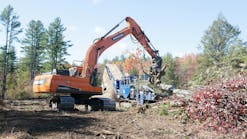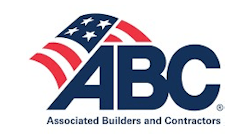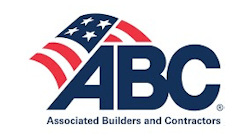A real-life manifestation of the adage “everything’s bigger in Texas,” recently took place on a huge tract of farmland about 35 miles northwest of Houston. There, global air conditioning supplier Daikin Industries Ltd., has built the world’s largest tilt-wall structure to house all facets of its operation (manufacturing, distribution, and office space), which previously existed in a number of separate buildings in Houston.
In fact, at 4.1 million square feet of total space, the building has become the second largest structure (in terms of square footage) of any kind in the world, trailing only Boeing’s Everett, WA, assembly plant at 4.3 million square feet. While the sheer magnitude of such a project could have been daunting—the site itself covers more than 500 acres—the earthmoving, grading, and concrete paving facets of the job moved along nicely, thanks to a cooperative GNSS effort between three of the major firms onsite. Joining forces to tackle a huge challenge? Also very Texas-like. Remember the Alamo.
Moving Mountains
Land clearing on Daikin’s new site, located near the town of Hockley, started in January 2015. That was followed by a massive earthmoving effort, which entailed movement of more than 1.8 million cubic yards of soil, according to Chase Baker, co-owner of Choctaw Construction Services (Katy, TX), one of several major subcontractors on the job.
“The general contractor for this project was the Houston office of Harvey Builders,” he says. “Burnside Services Inc. [BSI] acted as an earthmoving subcontractor to them, and we subbed to BSI, helping with some of the rough grading and handling the fine grading portion of the job as well. To move that massive volume of dirt, BSI and our company put together a fleet of Case 580 Tractors pulling 33-yard K-Tec 1233 scraper pans. The K-Tec scrapers have a higher ground clearance than any other pans available today and, given the often muddy conditions we had to deal with, really kept that facet of the project moving along. At one point, there were nearly two dozen Case/K-Tec tandems at work—it was quite a sight.”
The third component of the earthwork/grading effort, Houston-based Keystone Concrete Placement handled the fine grading work in advance of the more than 4.2 million square feet of concrete slabs for the structure, as well as an additional 4.5 million square feet for adjacent parking areas and access roads. The volumes of building material, like the project itself, were mind numbing: more than 360,000 cubic yards of concrete and 29,000 tons of steel used between the slabs, parking area (for 5,000 cars), and the 429 tilt-wall panels. Each panel measured 25-feet wide, with heights ranging from 50 to 60 feet. All told, the Daikin structure has more than 2 miles of tilt wall panels in place.
Texas Stake-Out
Conspicuously absent throughout the Daikin site was evidence of any grading stakes—impressive given the overall amount of earthmoving taking place. (BSI’s workload alone involved 20 million square feet of rough grading.) According to Baker, all three companies handling major earthmoving and grading almost entirely bypassed traditional surveying techniques in favor of GNSS machinery and equipment.
“We are pretty much all in agreement that there’s no way this job could have been done without using GPS,” he says. “Not only would we have needed an army of people out there setting blue-tops, the surveying costs associated with it would have been astronomical. Instead, because we all have experience with GNSS technology and own equipment with machine control on it, we worked with a couple of engineers who took the existing plans, created a digital model; and loaded it into our respective dozers, scrapers, graders, and excavators. Working off a single Topcon GR-5 receiver, we got to work.”
As a result of that consolidation of effort, BSI, Keystone, and Choctaw were all on the same page with regard to what needed to be done, what changes had been made, and so on. Baker says the Daikin job was ideal for machine control and examples of that occurred almost daily. “One of the biggest challenges was
the contour lines that we had to cut and the fact that the swales were all flatwork,” he says. “Everything out here sheet drains, so
trying to blue-top for all the different
angles, points, and swales would be next to impossible. Instead, we cut against the swales and the contour just formed and flowed. We did as much as a 75,000-square-foot block of fine grade in five hours, and did it with two operators: a dozer out in front and a grader behind him. Who can argue with that?”
All About the Yield
Though Keystone’s role differed from that of Choctaw’s and a far cry from the rough grading BSI handled, it was no less critical, nor demanding. For them, however, a NorAm 65E Turbo compact motor grader, equipped with Topcon 3D-MC2 machine control, proved ideal for the fine grading they did in advance of paving. Both were fairly new additions, according to John Lively, Keystone’s project superintendent.
“Keystone has a number of companies under one umbrella and one of those is an earthwork company that previously used Topcon GPS on a project they did—a parking lot for a local school district. It was so successful that, when we landed this job, we immediately purchased the NorAm motor grader and outfitted it with the full Topcon 3D-MC2system.”
Lively says that Choctaw initially got the grade to within 0.10 of a foot, but by the time his crews would get to working on it, things were run upon, compaction occurred, and such, making additional fine grading necessary. Failure to do so, particularly on a job of this size, could have wreaked havoc on their bottom line.
“With that huge an area, we were extremely sensitive to things being graded to the right elevation to eliminate the risk of over pouring,” says Lively. “A half inch of additional concrete across a site that large is a ton of money. So, after every pour, we monitored the yield: We took the square footage and the thickness, calculated how much we should have poured, and compared it to how much we actually did pour. A company like ours can have 2 to 3% overages and still remain profitable. We were well within that range thanks to the accuracy of the grade we got with the Topcon system.”
Elevation, Elevation, Elevation
The number of variables present at the Daikin site—the differing levels of work which would be taking place, whether or not heavy vehicle traffic would be present in an area, if machinery will be supported, and so on—was reflected in an equally varied range of pad and pavement thicknesses, according to Lively.
“Concrete thickness ran anywhere from five to 10 inches throughout the site,” he says. “And, to complicate matters, in many areas, the thicknesses were not segregated. We had parking lots in which the general area was seven inches thick but the drive lanes around it were nine inches. It varied greatly.”
With that overabundance of differing elevations, grading using traditional methods could also have been a nightmare. But GNSS, according to Baker, tackled it with surprising ease.
“It was really simple with the Topcon system,” he says. “We just dialed in the offsets and we were able to easily switch between the differing grades. Even though we have really good operators, just to ensure accuracy, we still regularly checked progress with rovers. But we were spot-on every step of the way.”
Supporting Role
Because of the centralized GNSS approach taken by the three contractors, all service and support was also through a single source: the Houston branch of GeoShack. Both Baker and Lively say that support was outstanding.
“Right from the outset, GeoShack was on top of this,” says Lively. “Scott Bird, their machine control specialist, recognized that we were fairly new to the technology, came out to the site to help us set up, and helped us all through some early-stage ‘hiccups.’ In addition, because of the amount of equipment we all had in place, GeoShack designated a full-time technician to be out there. So, whether we needed help with an issue or just wanted to further advance our understanding of the system, they were almost immediately available.”
Things went so well on the Daikin project that, despite heavy rains that impacted production, Choctaw was still able to meet the 2016 move-in date, and came in well ahead of their own self-imposed deadlines. “To go from an empty field to that—in just over a year—seems almost impossible,” says Baker. “But having us all ‘sharing’ the Topcon solution, so to speak, improved everyone’s efficiencies and made it very manageable.”













